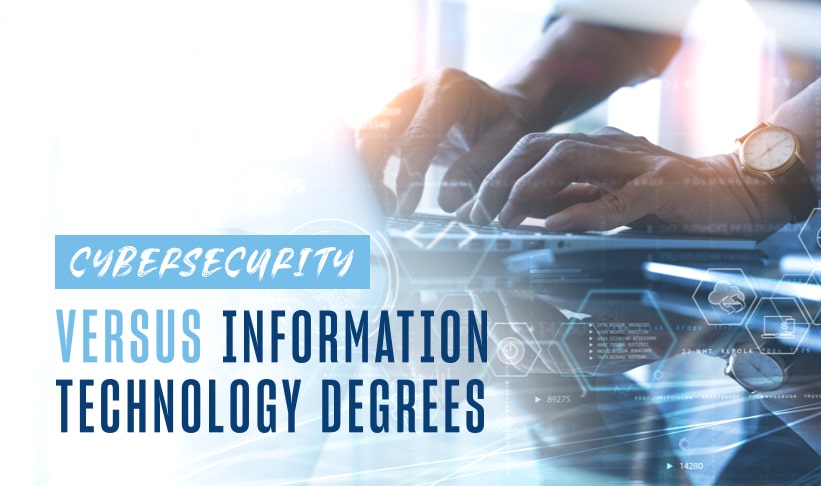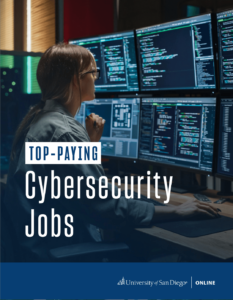Technology hiring has expanded for decades and education remains the most reliable way to access that opportunity. Information technology and cybersecurity sit at the center of this growth, defining how organizations build and protect themselves.
Over the past two years, tech hiring has become more selective as employers emphasize AI, automation and demonstrable skills in data, networks and security. That shift makes the choice between IT and cybersecurity especially consequential for anyone entering the tech job market.
This guide compares the two degree paths, including what you’ll study, the roles and pay each path supports and how to match your decision to the work you want. You’ll learn how each path aligns with current employer priorities, plus explore options if you plan to pursue a security-focused master’s.
What Is a Cybersecurity Degree?
A master’s degree in cybersecurity is intended for students with bachelor’s degrees who want to protect technology systems.
Typical coursework includes security architecture, identity and access management, vulnerability management, incident response, cryptography, cloud security and governance/risk/compliance. Lessons center on different types of cyber attacks, email phishing, data breaches and ransomware. Because of how quickly cyber threats evolve, professionals can also benefit from learning the latest developments in pursuit of a master’s degree in cybersecurity.
Graduates commonly pursue roles such as security analyst, penetration tester, security engineer, security architect or GRC (governance, risk and compliance) analyst.
What Is an Information Technology Degree?
A master’s degree in information technology prepares students for management-related positions in tech or to further develop their skills in a particular area of study, such as data analytics. Ideal participants have experience (or an undergraduate degree) in software engineering, computer engineering or computer science.
The curriculum typically spans a year or two, and commonly includes programming concepts for IT, business data communications, systems analysis, information resource management, e-commerce and data warehousing.
Many programs also cover networking, systems administration (Windows/Linux), databases, cloud platforms, scripting/automation fundamentals, enterprise applications and IT service management, skills that map directly to roles like systems or network administrator, systems analyst, database administrator and IT support.
What’s the Difference Between a Cybersecurity and Information Technology Degree?
The biggest difference between cybersecurity versus information technology is scope. An IT degree is more general, whereas a cybersecurity degree is typically specialized.
In practice, IT deals with the use of computers and networks, software development and infrastructure, while cybersecurity focuses on keeping those systems safe from attacks. Digital forensics and incident response also fall under the purview of a cybersecurity expert. A simple way to think about it: IT keeps technology running for the business; cybersecurity keeps that technology and the data it handles protected.
[RELATED] Which Cyber Security Program Is Right For You? Download our free infographic to help decide >>
Careers for Cybersecurity and Information Technology Degree Holders
Job outlook and earning potential are promising for both cybersecurity and IT specialists. Experts say the average annual cybersecurity salary is $93,395 — well above the average of $47,520 across industries. That’s also the case for IT specialists, who earn an average salary of $81,241. The salary ranges for each career are similar, from about $69,000 to $125,000 for cybersecurity professionals and $58,000 to $113,000 in IT.
Both paths offer strong earning potential and steady employer demand. Security-focused roles (e.g., information security analyst) generally report higher national median pay than many broad IT roles. The wider IT category continues to post large numbers of annual openings due to growth and replacement needs. Actual outcomes vary by role, experience, certifications and location.
Certifications can also influence salary by showing an employer that you invested the time to improve your skills and knowledge. Though not required, many technology professionals will opt for certifications as a means to stand out from other applicants. Common picks include Security+, Network+, CySA+, CISSP, CCSP and vendor certifications for cloud and networking.
Folks who earn an advanced cybersecurity degree typically land in the following positions:
- Cyber Threat Intelligence Analyst
- Cryptanalyst
- Computer Forensic Analyst
- Data Protection Officer
- Cybercrime Investigator
- Malware Analyst
- Security Consultant
- Chief Privacy Officer
- Information Security Analyst
- Network Security Engineer
- Security Architect
- Security Operations Center (SOC) Analyst
- Governance Risk and Compliance (GRC) Analyst
Advanced information technology degree holders report working in these roles:
- Computer and Information Research Scientist
- Computer Network Architect
- Computer Programmer
- Computer Support Specialist
- Computer Systems Analyst
- Software Developer
- IT Technician
- Support Specialist
- Web Developer
- Network Engineer
- Systems Administrator
- Cloud/IT Support Specialist
- IT Project Coordinator
CAREERS AND SALARY BY DEGREE
The following chart lists possible careers and projected salaries for candidates with each respective degree. Actual salary and earnings are always subject to individual employers, location and additional factors.
| Cybersecurity | Information Technology |
| Cybersecurity Engineer ($159,000) Penetration Tester ($151,000) Cybersecurity Architect ($205,000) Network Security Engineer ($160,000) Chief Information Security Officer ($282,000) | Database Engineer ($143,000) User Experience Designer ($109,000) Front-end Developer ($101,000) Data Warehouse Architect ($163,000) Site Reliability Engineer ($166,000) |
Salary estimates from Glassdoor. Estimates often update in real time based on changing data.
COURSEWORK COMPARISON
These cybersecurity courses are specific to the University of San Diego.
| Cybersecurity | Information Technology |
| Foundations of Cybersecurity Applied Cryptography Enterprise Security Architecture Cybersecurity Law and Policy Software Design and Development | Fundamentals of IT Leadership Server Operations DevOps IT Service Management Enterprise Applications, Data Management and Reporting |
INDUSTRY DEMAND
| Cybersecurity | Information Technology |
| Information security analysts / cybersecurity jobs are projected to grow 33% in the 10 years from 2023 to 2033; much faster than the 4% average for all occupations. | Computer and information technology jobs are also projected to grow much faster than the average for all occupations from 2023 to 2033. About 356,700 openings are projected each year, on average |
Based on projections from the U.S. Department of Labor Statistics
Which Degree Is Right for Me?
The process of deciding which degree to pursue is uniquely personal. Your decision will be based on your own interests and career goals. To help determine the best fit, ask yourself the following questions:
- Does the program align with my budget and schedule?
- Am I interested in the broader study of computers (IT) or protecting those systems (cybersecurity)?
- Can I leverage my personal experience to excel in a particular program?
- Where have past students ended up working after completing the program?
Learn more about the value of a cybersecurity degree over time, career outlook and the benefits of an online education with the USD eBook, Getting a Degree in Cybersecurity: 8 Important Considerations.





